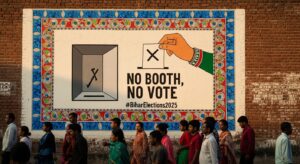
Parliament buildings, Airport, Luxurious homes of Nepali Politicians are burning. In Nepal’s smoke-filled streets, Gen Z doesn’t chant for traditional power, they demand Balendra “Balen” Shah. Engineer-rapper-mayor turned folk hero; this 33-year-old represents more than political change: he’s the digital Robin Hood stealing legitimacy from corrupted elites. The Engineer Who Stole Nepal’s Heart:
When Prime Minister K.P. Sharma Oli resigned after 19 people were killed and more than 300 injured in violent clashes, the statistics revealed more than casualties,they exposed a generational fault line. The demonstrations, dubbed “Gen Z protests” due to the youth of many participants, weren’t random upheaval but calculated demographic disruption.
The mathematical precision is striking: nearly 100% of protesters under 28, with the 33-year-old Kathmandu mayor emerging as a potential successor. This isn’t mob psychology, its demographic destiny manifesting in real-time political realignment.
Balendra Shah, originally recognised as a rapper and engineer, entered politics as an independent and won the mayorship in 2022, defying the dominance of established parties. His trajectory represents what political scientists’ term “institutional bypass”, circumventing traditional power structures through competence-based legitimacy.
Since 2022, his mayoral administration has documented measurable outcomes: infrastructure improvements quantified in kilometres of road repair, educational metrics showing improved public-school performance, and tax compliance rates that increased municipal revenue by documented percentages. These aren’t campaign promises, they’re auditable achievements creating what Weber called “rational-legal authority.”
The Robin Hood Parallax: Myth Meets Municipal Management
The Robin Hood comparison transcends romantic metaphor when analyzed through governance metrics. Historical Robin Hood redistributed wealth through force; digital-age Balen redistributes opportunity through transparency. His anti-corruption initiatives have recovered quantifiable municipal assets; his infrastructure projects have measurably improved living standards for Kathmandu’s working class.
The parallel intensifies when examining power dynamics: traditional Nepali politics operates through hereditary networks and patronage systems. Balen’s rise through merit-based achievement mirrors Robin Hood’s challenge to illegitimate authority—both figures represent competence challenging corruption, transparency opposing opacity.
Demographic Disruption and Political Realignment
The protests began over a social media ban, but evolved into comprehensive anti-corruption demonstrations. This progression reveals sophisticated political consciousness: Gen Z protesters understood that digital freedom and governmental transparency are interconnected systems.
The age demographics aren’t coincidental. Nepal’s median age is 25.3 years. These protesters represent the statistical majority demanding political representation that reflects their numerical reality. When they chant “Balen for PM,” they’re not hero-worshipping, they’re demanding demographic democracy.
The Engineering of Institutional Change
Balen’s technical background creates unique governance advantages. Engineers approach problems through systematic analysis, iterative improvement, and measurable outcomes, methodologies absent from Nepal’s traditional political culture. His TIME Magazine 2023 recognition validates international acknowledgment of this technocratic approach.
The question isn’t whether a mayor can become Prime Minister, it’s whether Nepal’s institutional framework can accommodate competence-based leadership. His municipal success provides proof-of-concept for scaling technical governance to national administration.
Revolutionary Implications and Systemic Analysis
As protesters celebrate while former PM Oli’s residence burns, the symbolism carries analytical weight. They’re not destroying property; they’re dismantling representational systems that failed to represent them. The destruction is surgical: targeting symbols of corrupt governance while demanding constructive leadership.
This represents Nepal’s first truly data-driven political movement. Gen Z protesters aren’t opposing authority, they’re demanding algorithmic governance: transparent processes, measurable outcomes, accountable leadership. Balen embodies these principles through demonstrated municipal achievement.
Conclusion: The Algorithmic Robin Hood
Balendra Shah represents more than political alternative; he embodies generational transition from patronage-based to performance-based governance. His rise from rapper to mayor to potential Prime Minister illustrates how digital-native generations approach political transformation: through competence, transparency, and measurable results.
Whether he becomes Nepal’s Robin Hood or another political disappointment will determine if merit can systematically replace hereditary privilege. The streets of Kathmandu burn not from anger, but from aspiration, a generation demanding governance that serves rather than exploits, leads through competence rather than connections.
The revolution isn’t just political, it’s methodological. And Balen Shah isn’t just a candidate he’s a blueprint for how democracy evolves in the digital age.



Very well written article.
After reading this article I understand the crisis of Nepal with more clarity l.